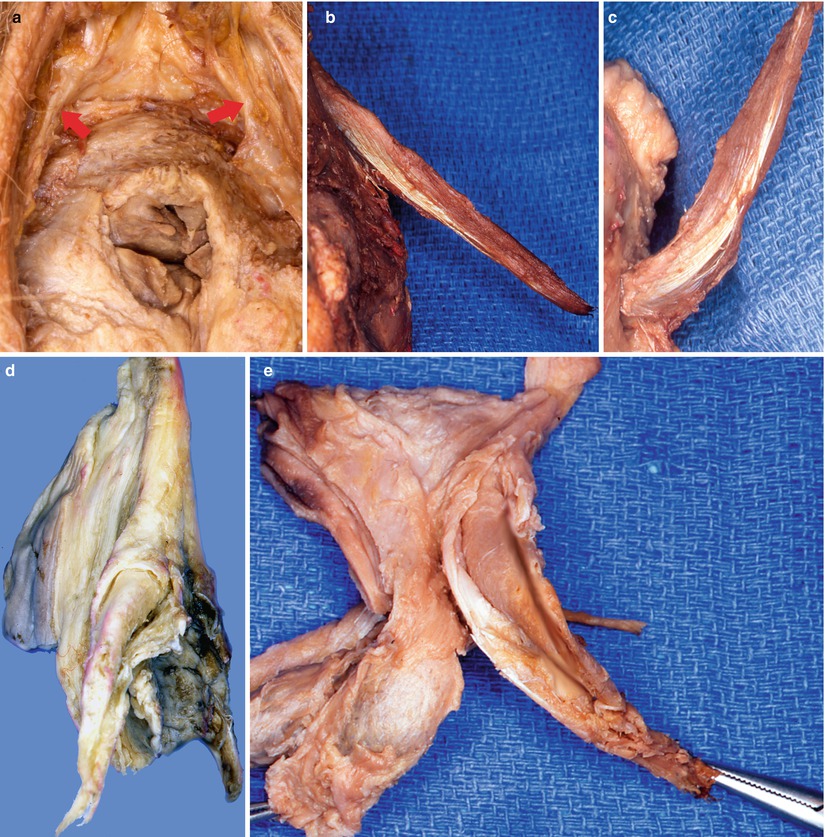and Hubert Lepidi1
(1)
UER Médecine, Aix-Marseille Université, Marseille, France
Abstract
These muscles (4 overall) are symmetrical, paired and striated muscles, which are divided into two groups: the group of the ischiocavernosus muscles (connected to the crura of the clitoral corpora cavernosa) and the group of the bulbospongiosus muscles (connected to the spongy bulbs). These muscles also exist at the level of man’s perineum, in which case they are connected to the corpora cavernosa and to the spongy corpus of the penis.
These muscles (4 overall) are symmetrical, paired and striated muscles, which are divided into two groups: the group of the ischiocavernosus muscles (connected to the crura of the clitoral corpora cavernosa) and the group of the bulbospongiosus muscles (connected to the spongy bulbs). These muscles also exist at the level of man’s perineum, in which case they are connected to the corpora cavernosa and to the spongy corpus of the penis.
These 4 muscles are located in the superficial region of the anterior perineum (urogenital perineum), between the superficial fascia of the perineum (fascia of Colles) and the inferior fascia of the urogenital diaphragm, i.e. the perineal membrane. They are innervated by branches from the perineal ramus of the pudendal nerve.
Their role is essential for the mobility of the clitoris and its erectile function.
11.1 Ischiocavernosus Muscles
Over time, they have been given very diverse names: tertius and quartus musculus (Colombo), clitoridis musculus (Fallope), clitoridis musculus tensioni dicatus (Laurent), superior rotundus (Riolan), ischio-clitoral (Dumas and then Testut), erector clitoridis (Cowper, Albinus, Soemmering), ischio-sub-clitoridis, ischio-urethralis (Chaussier) and collateralis sive penem erigens (Spigel). The current terminology is the terminology which had already been adopted by Winslow, Bichat, Portal, Boyden, etc., in their time.
According to traditional descriptions, the ischiocavernosus muscles resemble half-cones enveloping each of the 2 crura of the clitoris at the level of their inferior and medial surfaces. The insertion of each ischiocavernosus muscle is made on either side of the osseous or osteofibrous insertions of the clitoral crus, which it covers.
We have observed that reality appeared to be slightly different.
Each crus clitoridis is completely surrounded by its ischiocavernosus muscle, which, furthermore, protrudes therefrom by 1 or 3 cm downwards. The clitoral ischiocavernosus muscle is not, such as often described, a small muscle of no importance, with much smaller dimensions than its penile counterpart. We even think that it is the opposite: if a ratio is established between the dimensions of this muscle in women and the dimensions of the thin and short crus, which it covers, it is observed that the clitoral ischiocavernosus muscle represents a powerful and bulky muscle, with major functional capacities. Such as already noted by L. Kobelt, “its length is of 8 cm, sometimes more still, so as to be compatible with the dimensions of the woman’s pubic arcade”.
Another observation resulting from our experiment: The ischiocavernosus muscle has all of the characteristics of a penniform muscle, i.e. of a muscle “with less shortening possibilities but with the capacity to develop a greater force”: tendon of origin, medial, very long and very solid, aponeurosis originating from this tendon and enclosing the crus, oblique muscular bundles, originating from the tendon and pushed against the inferior and medial surfaces of the aponeurosis, short terminal and tendinous fibres.
The insertions of the ischiocavernosus muscle are particular (Fig. 11.1):

Fig. 11.1
Aspects of the ischiocavernosus muscles. (a) The two ischiocavernosus muscles on a perineal view of the anterior perineum (crura clitoridis dissected and pushed towards the pubis); the red arrows show the tendons of the two muscles. (b) The tendon of the left ischiocavernosus muscle on an anterior view of an anatomic specimen (notice the medial position of this tendon). (c) Inferior view of the same tendon (after raising of the left crus clitoridis). (d) Dorsolateral view of a bulbo-clitoral organ showing the left crus released after longitudinal opening of the ischiocavernosus fibro-muscular layer. (e) Left lateral view of a bulbo-clitoral organ, showing the left crus dissected and released from its fibro-muscular sheath (driven by a clamp)
It is firstly attached via its tendon of origin, onto the ischial tuberosity. It then takes, via its aponeurosis, osteofibrous attachments, which, on the one hand, are osseous over the ¾ of the ischio-pubic ramus, from the ischial tuberosity, and on the other hand fibrous on the adjacent part of the perineal membrane (thickened as an “attaching lamina of the corpora cavernosa”).1
From these origins is formed a not very thick, flattened muscle, rolled up like a cone (and not a half-cone, such as described in too many cases) around the crus clitoridis. Thus, the body of the muscle truly encloses the erectile body so that the latter is not visible. In order to observe the crus, it is therefore necessary to longitudinally incise the lower surface of the musculo-aponeurotic envelope and release this crus from this pearly envelope (Fig. 11.1). This operation is delicate due to the fact that very tight adherences connect the albuginea of the crus and the internal surface of the aponeurosis of the ischiocavernosus muscle. When the crus is completely released, the hollow aponeurotic cylinder, inside which it was located, is clearly visible and appears shiny and pearly, completely intact and uninterrupted in its attachment region. There obviously are no muscle fibres on this internal surface. It is thus understood that insertions onto the perineal membrane are made via the external surface of the cone and not via the crus.
Stay updated, free articles. Join our Telegram channel

Full access? Get Clinical Tree








